NURSING CARE: Community Nursing Strategies for Diabetes and Smoking
VerifiedAdded on 2023/06/14
|7
|2460
|125
Case Study
AI Summary
This nursing case study examines the care of a 52-year-old male patient with type 2 diabetes, obesity, and a 30-year smoking history. The study identifies two key nursing interventions: promoting smoking cessation and regulating blood glucose levels. The patient's risk factors, including obesity and elevated blood glucose, are discussed, and a plan of action is proposed, involving weight management, exercise, and home care support. The importance of monitoring blood glucose levels and providing patient education is emphasized. For smoking cessation, the study highlights the nurse's role in counseling, implementing the '5 A's' (Ask, Advise, Assess, Assist, Arrange), and offering ongoing support. The ultimate goal is to improve the patient's overall health and prevent further complications. This document is available on Desklib, where students can find similar case studies and study resources.
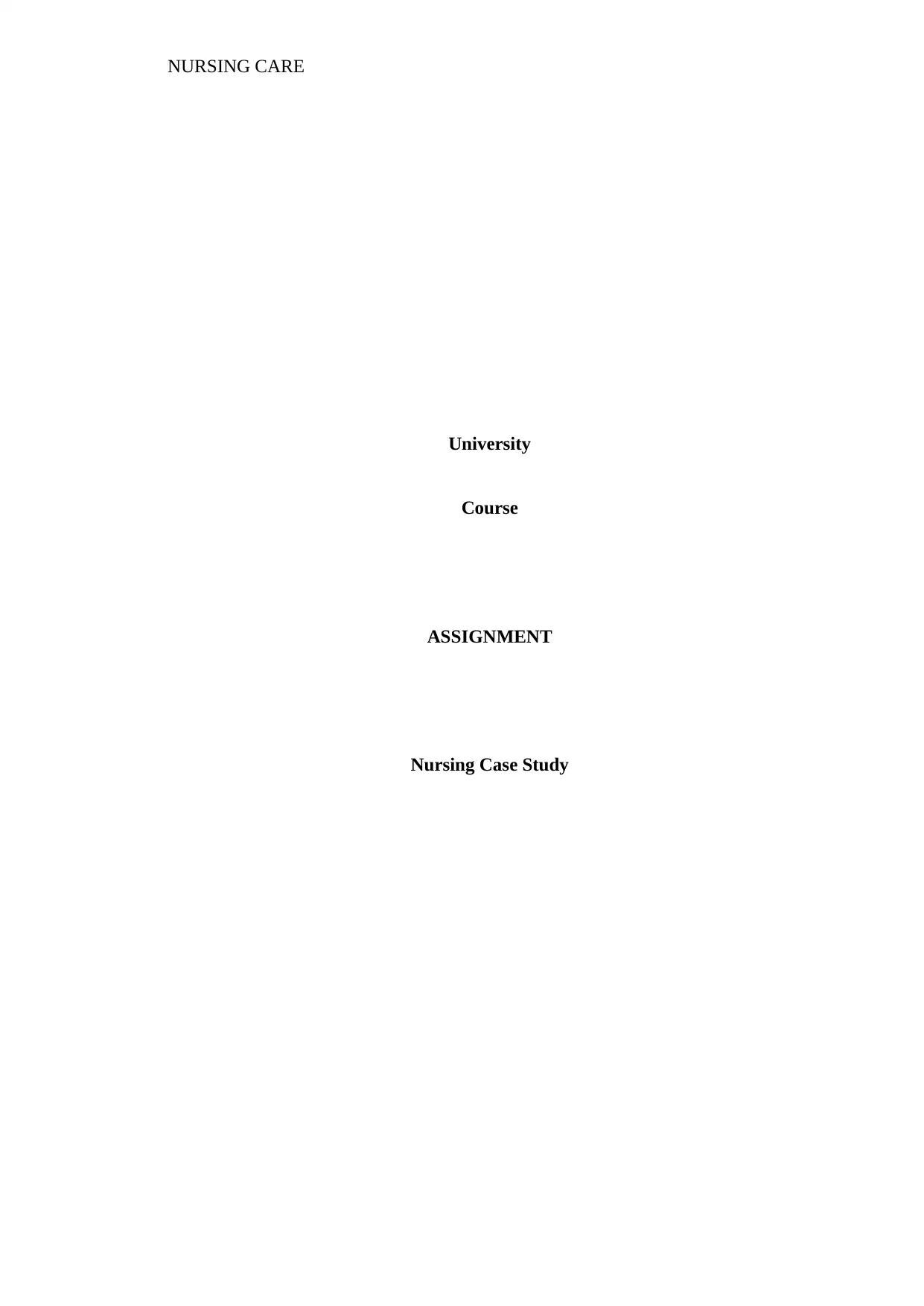
NURSING CARE
University
Course
ASSIGNMENT
Nursing Case Study
University
Course
ASSIGNMENT
Nursing Case Study
Paraphrase This Document
Need a fresh take? Get an instant paraphrase of this document with our AI Paraphraser
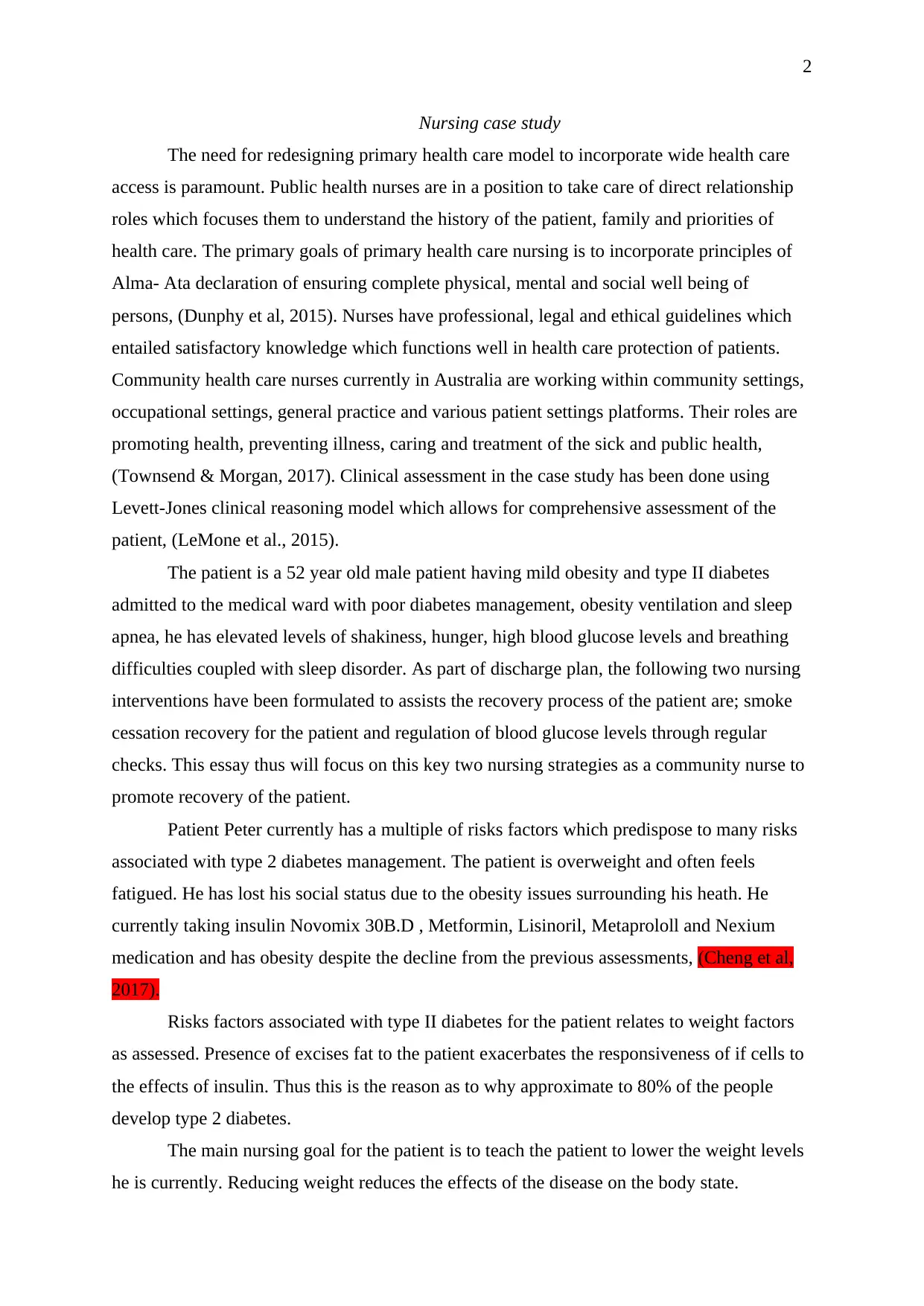
2
Nursing case study
The need for redesigning primary health care model to incorporate wide health care
access is paramount. Public health nurses are in a position to take care of direct relationship
roles which focuses them to understand the history of the patient, family and priorities of
health care. The primary goals of primary health care nursing is to incorporate principles of
Alma- Ata declaration of ensuring complete physical, mental and social well being of
persons, (Dunphy et al, 2015). Nurses have professional, legal and ethical guidelines which
entailed satisfactory knowledge which functions well in health care protection of patients.
Community health care nurses currently in Australia are working within community settings,
occupational settings, general practice and various patient settings platforms. Their roles are
promoting health, preventing illness, caring and treatment of the sick and public health,
(Townsend & Morgan, 2017). Clinical assessment in the case study has been done using
Levett-Jones clinical reasoning model which allows for comprehensive assessment of the
patient, (LeMone et al., 2015).
The patient is a 52 year old male patient having mild obesity and type II diabetes
admitted to the medical ward with poor diabetes management, obesity ventilation and sleep
apnea, he has elevated levels of shakiness, hunger, high blood glucose levels and breathing
difficulties coupled with sleep disorder. As part of discharge plan, the following two nursing
interventions have been formulated to assists the recovery process of the patient are; smoke
cessation recovery for the patient and regulation of blood glucose levels through regular
checks. This essay thus will focus on this key two nursing strategies as a community nurse to
promote recovery of the patient.
Patient Peter currently has a multiple of risks factors which predispose to many risks
associated with type 2 diabetes management. The patient is overweight and often feels
fatigued. He has lost his social status due to the obesity issues surrounding his heath. He
currently taking insulin Novomix 30B.D , Metformin, Lisinoril, Metaprololl and Nexium
medication and has obesity despite the decline from the previous assessments, (Cheng et al,
2017).
Risks factors associated with type II diabetes for the patient relates to weight factors
as assessed. Presence of excises fat to the patient exacerbates the responsiveness of if cells to
the effects of insulin. Thus this is the reason as to why approximate to 80% of the people
develop type 2 diabetes.
The main nursing goal for the patient is to teach the patient to lower the weight levels
he is currently. Reducing weight reduces the effects of the disease on the body state.
Nursing case study
The need for redesigning primary health care model to incorporate wide health care
access is paramount. Public health nurses are in a position to take care of direct relationship
roles which focuses them to understand the history of the patient, family and priorities of
health care. The primary goals of primary health care nursing is to incorporate principles of
Alma- Ata declaration of ensuring complete physical, mental and social well being of
persons, (Dunphy et al, 2015). Nurses have professional, legal and ethical guidelines which
entailed satisfactory knowledge which functions well in health care protection of patients.
Community health care nurses currently in Australia are working within community settings,
occupational settings, general practice and various patient settings platforms. Their roles are
promoting health, preventing illness, caring and treatment of the sick and public health,
(Townsend & Morgan, 2017). Clinical assessment in the case study has been done using
Levett-Jones clinical reasoning model which allows for comprehensive assessment of the
patient, (LeMone et al., 2015).
The patient is a 52 year old male patient having mild obesity and type II diabetes
admitted to the medical ward with poor diabetes management, obesity ventilation and sleep
apnea, he has elevated levels of shakiness, hunger, high blood glucose levels and breathing
difficulties coupled with sleep disorder. As part of discharge plan, the following two nursing
interventions have been formulated to assists the recovery process of the patient are; smoke
cessation recovery for the patient and regulation of blood glucose levels through regular
checks. This essay thus will focus on this key two nursing strategies as a community nurse to
promote recovery of the patient.
Patient Peter currently has a multiple of risks factors which predispose to many risks
associated with type 2 diabetes management. The patient is overweight and often feels
fatigued. He has lost his social status due to the obesity issues surrounding his heath. He
currently taking insulin Novomix 30B.D , Metformin, Lisinoril, Metaprololl and Nexium
medication and has obesity despite the decline from the previous assessments, (Cheng et al,
2017).
Risks factors associated with type II diabetes for the patient relates to weight factors
as assessed. Presence of excises fat to the patient exacerbates the responsiveness of if cells to
the effects of insulin. Thus this is the reason as to why approximate to 80% of the people
develop type 2 diabetes.
The main nursing goal for the patient is to teach the patient to lower the weight levels
he is currently. Reducing weight reduces the effects of the disease on the body state.
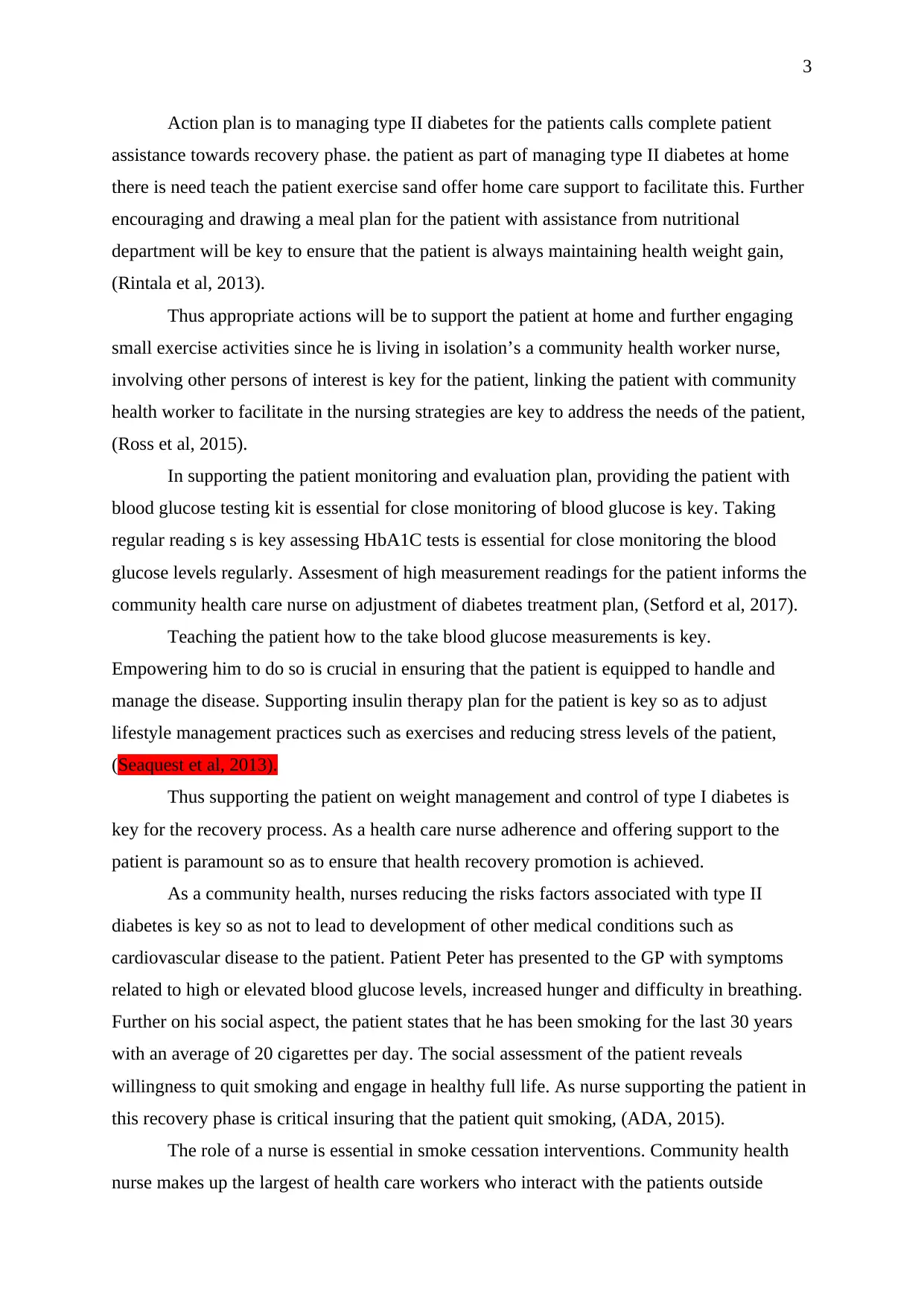
3
Action plan is to managing type II diabetes for the patients calls complete patient
assistance towards recovery phase. the patient as part of managing type II diabetes at home
there is need teach the patient exercise sand offer home care support to facilitate this. Further
encouraging and drawing a meal plan for the patient with assistance from nutritional
department will be key to ensure that the patient is always maintaining health weight gain,
(Rintala et al, 2013).
Thus appropriate actions will be to support the patient at home and further engaging
small exercise activities since he is living in isolation’s a community health worker nurse,
involving other persons of interest is key for the patient, linking the patient with community
health worker to facilitate in the nursing strategies are key to address the needs of the patient,
(Ross et al, 2015).
In supporting the patient monitoring and evaluation plan, providing the patient with
blood glucose testing kit is essential for close monitoring of blood glucose is key. Taking
regular reading s is key assessing HbA1C tests is essential for close monitoring the blood
glucose levels regularly. Assesment of high measurement readings for the patient informs the
community health care nurse on adjustment of diabetes treatment plan, (Setford et al, 2017).
Teaching the patient how to the take blood glucose measurements is key.
Empowering him to do so is crucial in ensuring that the patient is equipped to handle and
manage the disease. Supporting insulin therapy plan for the patient is key so as to adjust
lifestyle management practices such as exercises and reducing stress levels of the patient,
(Seaquest et al, 2013).
Thus supporting the patient on weight management and control of type I diabetes is
key for the recovery process. As a health care nurse adherence and offering support to the
patient is paramount so as to ensure that health recovery promotion is achieved.
As a community health, nurses reducing the risks factors associated with type II
diabetes is key so as not to lead to development of other medical conditions such as
cardiovascular disease to the patient. Patient Peter has presented to the GP with symptoms
related to high or elevated blood glucose levels, increased hunger and difficulty in breathing.
Further on his social aspect, the patient states that he has been smoking for the last 30 years
with an average of 20 cigarettes per day. The social assessment of the patient reveals
willingness to quit smoking and engage in healthy full life. As nurse supporting the patient in
this recovery phase is critical insuring that the patient quit smoking, (ADA, 2015).
The role of a nurse is essential in smoke cessation interventions. Community health
nurse makes up the largest of health care workers who interact with the patients outside
Action plan is to managing type II diabetes for the patients calls complete patient
assistance towards recovery phase. the patient as part of managing type II diabetes at home
there is need teach the patient exercise sand offer home care support to facilitate this. Further
encouraging and drawing a meal plan for the patient with assistance from nutritional
department will be key to ensure that the patient is always maintaining health weight gain,
(Rintala et al, 2013).
Thus appropriate actions will be to support the patient at home and further engaging
small exercise activities since he is living in isolation’s a community health worker nurse,
involving other persons of interest is key for the patient, linking the patient with community
health worker to facilitate in the nursing strategies are key to address the needs of the patient,
(Ross et al, 2015).
In supporting the patient monitoring and evaluation plan, providing the patient with
blood glucose testing kit is essential for close monitoring of blood glucose is key. Taking
regular reading s is key assessing HbA1C tests is essential for close monitoring the blood
glucose levels regularly. Assesment of high measurement readings for the patient informs the
community health care nurse on adjustment of diabetes treatment plan, (Setford et al, 2017).
Teaching the patient how to the take blood glucose measurements is key.
Empowering him to do so is crucial in ensuring that the patient is equipped to handle and
manage the disease. Supporting insulin therapy plan for the patient is key so as to adjust
lifestyle management practices such as exercises and reducing stress levels of the patient,
(Seaquest et al, 2013).
Thus supporting the patient on weight management and control of type I diabetes is
key for the recovery process. As a health care nurse adherence and offering support to the
patient is paramount so as to ensure that health recovery promotion is achieved.
As a community health, nurses reducing the risks factors associated with type II
diabetes is key so as not to lead to development of other medical conditions such as
cardiovascular disease to the patient. Patient Peter has presented to the GP with symptoms
related to high or elevated blood glucose levels, increased hunger and difficulty in breathing.
Further on his social aspect, the patient states that he has been smoking for the last 30 years
with an average of 20 cigarettes per day. The social assessment of the patient reveals
willingness to quit smoking and engage in healthy full life. As nurse supporting the patient in
this recovery phase is critical insuring that the patient quit smoking, (ADA, 2015).
The role of a nurse is essential in smoke cessation interventions. Community health
nurse makes up the largest of health care workers who interact with the patients outside
⊘ This is a preview!⊘
Do you want full access?
Subscribe today to unlock all pages.

Trusted by 1+ million students worldwide
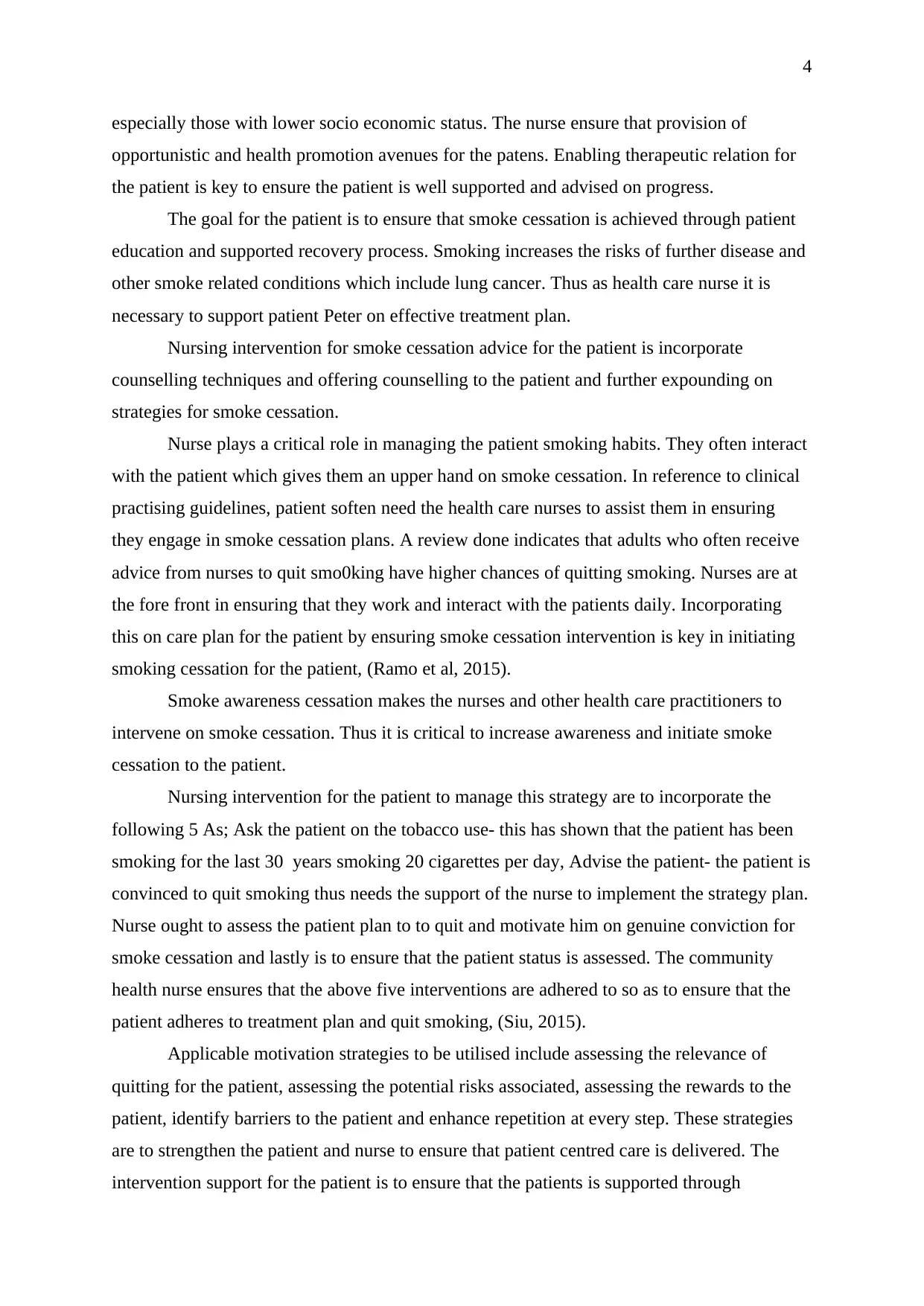
4
especially those with lower socio economic status. The nurse ensure that provision of
opportunistic and health promotion avenues for the patens. Enabling therapeutic relation for
the patient is key to ensure the patient is well supported and advised on progress.
The goal for the patient is to ensure that smoke cessation is achieved through patient
education and supported recovery process. Smoking increases the risks of further disease and
other smoke related conditions which include lung cancer. Thus as health care nurse it is
necessary to support patient Peter on effective treatment plan.
Nursing intervention for smoke cessation advice for the patient is incorporate
counselling techniques and offering counselling to the patient and further expounding on
strategies for smoke cessation.
Nurse plays a critical role in managing the patient smoking habits. They often interact
with the patient which gives them an upper hand on smoke cessation. In reference to clinical
practising guidelines, patient soften need the health care nurses to assist them in ensuring
they engage in smoke cessation plans. A review done indicates that adults who often receive
advice from nurses to quit smo0king have higher chances of quitting smoking. Nurses are at
the fore front in ensuring that they work and interact with the patients daily. Incorporating
this on care plan for the patient by ensuring smoke cessation intervention is key in initiating
smoking cessation for the patient, (Ramo et al, 2015).
Smoke awareness cessation makes the nurses and other health care practitioners to
intervene on smoke cessation. Thus it is critical to increase awareness and initiate smoke
cessation to the patient.
Nursing intervention for the patient to manage this strategy are to incorporate the
following 5 As; Ask the patient on the tobacco use- this has shown that the patient has been
smoking for the last 30 years smoking 20 cigarettes per day, Advise the patient- the patient is
convinced to quit smoking thus needs the support of the nurse to implement the strategy plan.
Nurse ought to assess the patient plan to to quit and motivate him on genuine conviction for
smoke cessation and lastly is to ensure that the patient status is assessed. The community
health nurse ensures that the above five interventions are adhered to so as to ensure that the
patient adheres to treatment plan and quit smoking, (Siu, 2015).
Applicable motivation strategies to be utilised include assessing the relevance of
quitting for the patient, assessing the potential risks associated, assessing the rewards to the
patient, identify barriers to the patient and enhance repetition at every step. These strategies
are to strengthen the patient and nurse to ensure that patient centred care is delivered. The
intervention support for the patient is to ensure that the patients is supported through
especially those with lower socio economic status. The nurse ensure that provision of
opportunistic and health promotion avenues for the patens. Enabling therapeutic relation for
the patient is key to ensure the patient is well supported and advised on progress.
The goal for the patient is to ensure that smoke cessation is achieved through patient
education and supported recovery process. Smoking increases the risks of further disease and
other smoke related conditions which include lung cancer. Thus as health care nurse it is
necessary to support patient Peter on effective treatment plan.
Nursing intervention for smoke cessation advice for the patient is incorporate
counselling techniques and offering counselling to the patient and further expounding on
strategies for smoke cessation.
Nurse plays a critical role in managing the patient smoking habits. They often interact
with the patient which gives them an upper hand on smoke cessation. In reference to clinical
practising guidelines, patient soften need the health care nurses to assist them in ensuring
they engage in smoke cessation plans. A review done indicates that adults who often receive
advice from nurses to quit smo0king have higher chances of quitting smoking. Nurses are at
the fore front in ensuring that they work and interact with the patients daily. Incorporating
this on care plan for the patient by ensuring smoke cessation intervention is key in initiating
smoking cessation for the patient, (Ramo et al, 2015).
Smoke awareness cessation makes the nurses and other health care practitioners to
intervene on smoke cessation. Thus it is critical to increase awareness and initiate smoke
cessation to the patient.
Nursing intervention for the patient to manage this strategy are to incorporate the
following 5 As; Ask the patient on the tobacco use- this has shown that the patient has been
smoking for the last 30 years smoking 20 cigarettes per day, Advise the patient- the patient is
convinced to quit smoking thus needs the support of the nurse to implement the strategy plan.
Nurse ought to assess the patient plan to to quit and motivate him on genuine conviction for
smoke cessation and lastly is to ensure that the patient status is assessed. The community
health nurse ensures that the above five interventions are adhered to so as to ensure that the
patient adheres to treatment plan and quit smoking, (Siu, 2015).
Applicable motivation strategies to be utilised include assessing the relevance of
quitting for the patient, assessing the potential risks associated, assessing the rewards to the
patient, identify barriers to the patient and enhance repetition at every step. These strategies
are to strengthen the patient and nurse to ensure that patient centred care is delivered. The
intervention support for the patient is to ensure that the patients is supported through
Paraphrase This Document
Need a fresh take? Get an instant paraphrase of this document with our AI Paraphraser
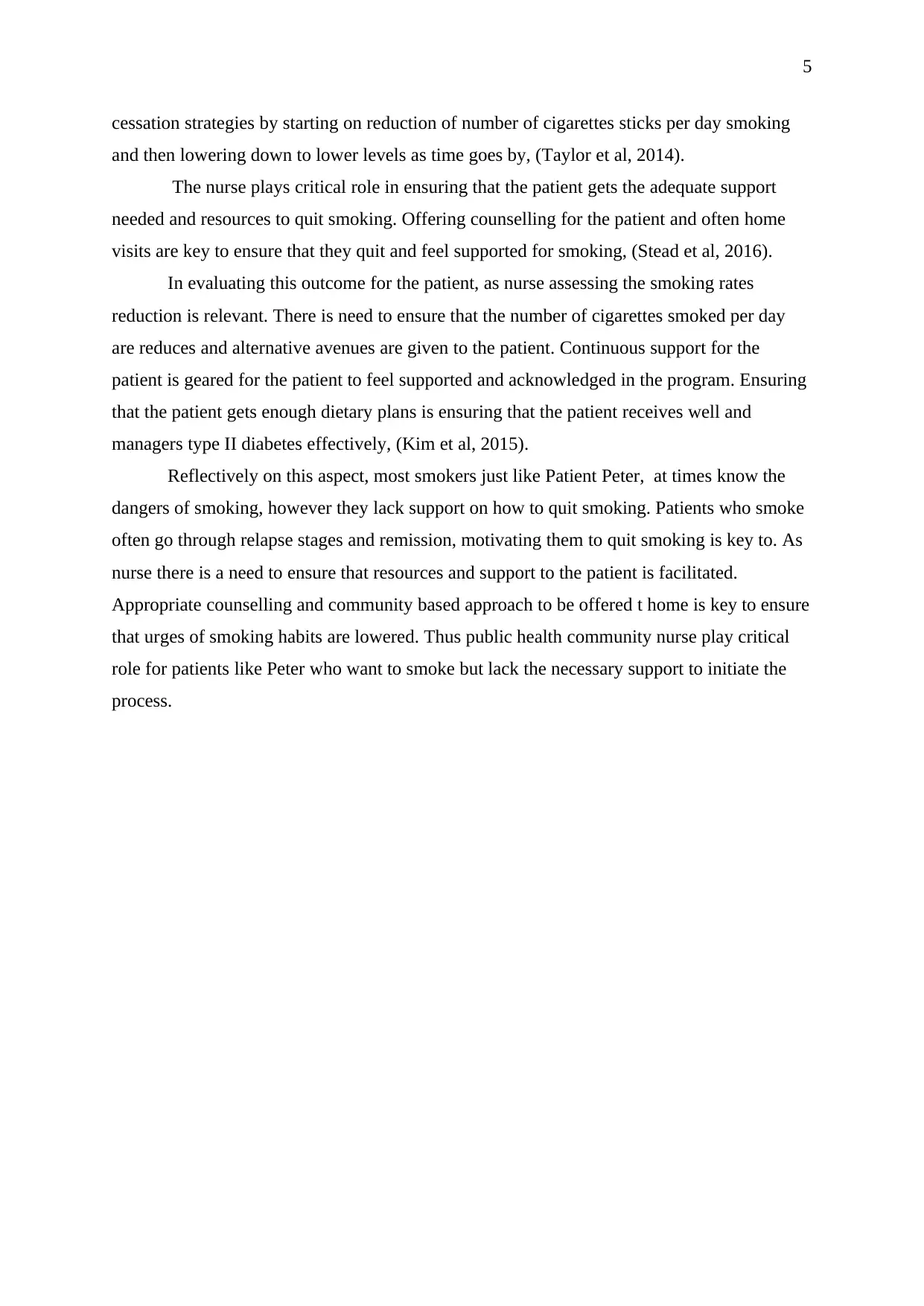
5
cessation strategies by starting on reduction of number of cigarettes sticks per day smoking
and then lowering down to lower levels as time goes by, (Taylor et al, 2014).
The nurse plays critical role in ensuring that the patient gets the adequate support
needed and resources to quit smoking. Offering counselling for the patient and often home
visits are key to ensure that they quit and feel supported for smoking, (Stead et al, 2016).
In evaluating this outcome for the patient, as nurse assessing the smoking rates
reduction is relevant. There is need to ensure that the number of cigarettes smoked per day
are reduces and alternative avenues are given to the patient. Continuous support for the
patient is geared for the patient to feel supported and acknowledged in the program. Ensuring
that the patient gets enough dietary plans is ensuring that the patient receives well and
managers type II diabetes effectively, (Kim et al, 2015).
Reflectively on this aspect, most smokers just like Patient Peter, at times know the
dangers of smoking, however they lack support on how to quit smoking. Patients who smoke
often go through relapse stages and remission, motivating them to quit smoking is key to. As
nurse there is a need to ensure that resources and support to the patient is facilitated.
Appropriate counselling and community based approach to be offered t home is key to ensure
that urges of smoking habits are lowered. Thus public health community nurse play critical
role for patients like Peter who want to smoke but lack the necessary support to initiate the
process.
cessation strategies by starting on reduction of number of cigarettes sticks per day smoking
and then lowering down to lower levels as time goes by, (Taylor et al, 2014).
The nurse plays critical role in ensuring that the patient gets the adequate support
needed and resources to quit smoking. Offering counselling for the patient and often home
visits are key to ensure that they quit and feel supported for smoking, (Stead et al, 2016).
In evaluating this outcome for the patient, as nurse assessing the smoking rates
reduction is relevant. There is need to ensure that the number of cigarettes smoked per day
are reduces and alternative avenues are given to the patient. Continuous support for the
patient is geared for the patient to feel supported and acknowledged in the program. Ensuring
that the patient gets enough dietary plans is ensuring that the patient receives well and
managers type II diabetes effectively, (Kim et al, 2015).
Reflectively on this aspect, most smokers just like Patient Peter, at times know the
dangers of smoking, however they lack support on how to quit smoking. Patients who smoke
often go through relapse stages and remission, motivating them to quit smoking is key to. As
nurse there is a need to ensure that resources and support to the patient is facilitated.
Appropriate counselling and community based approach to be offered t home is key to ensure
that urges of smoking habits are lowered. Thus public health community nurse play critical
role for patients like Peter who want to smoke but lack the necessary support to initiate the
process.
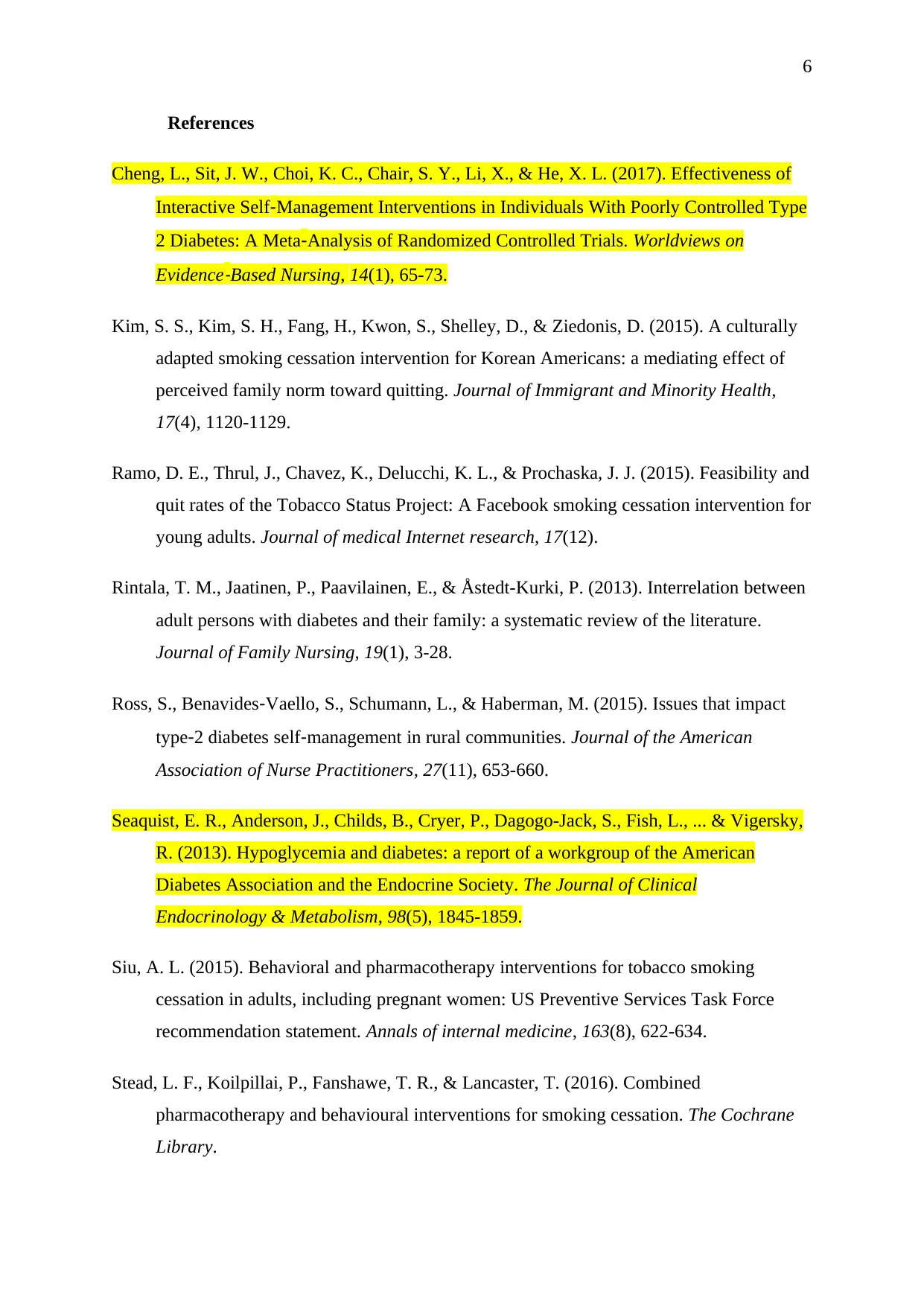
6
References
Cheng, L., Sit, J. W., Choi, K. C., Chair, S. Y., Li, X., & He, X. L. (2017). Effectiveness of
Interactive Self‐Management Interventions in Individuals With Poorly Controlled Type
2 Diabetes: A Meta‐Analysis of Randomized Controlled Trials. Worldviews on
Evidence
‐Based Nursing, 14(1), 65-73.
Kim, S. S., Kim, S. H., Fang, H., Kwon, S., Shelley, D., & Ziedonis, D. (2015). A culturally
adapted smoking cessation intervention for Korean Americans: a mediating effect of
perceived family norm toward quitting. Journal of Immigrant and Minority Health,
17(4), 1120-1129.
Ramo, D. E., Thrul, J., Chavez, K., Delucchi, K. L., & Prochaska, J. J. (2015). Feasibility and
quit rates of the Tobacco Status Project: A Facebook smoking cessation intervention for
young adults. Journal of medical Internet research, 17(12).
Rintala, T. M., Jaatinen, P., Paavilainen, E., & Åstedt-Kurki, P. (2013). Interrelation between
adult persons with diabetes and their family: a systematic review of the literature.
Journal of Family Nursing, 19(1), 3-28.
Ross, S., Benavides‐Vaello, S., Schumann, L., & Haberman, M. (2015). Issues that impact
type‐2 diabetes self‐management in rural communities. Journal of the American
Association of Nurse Practitioners, 27(11), 653-660.
Seaquist, E. R., Anderson, J., Childs, B., Cryer, P., Dagogo-Jack, S., Fish, L., ... & Vigersky,
R. (2013). Hypoglycemia and diabetes: a report of a workgroup of the American
Diabetes Association and the Endocrine Society. The Journal of Clinical
Endocrinology & Metabolism, 98(5), 1845-1859.
Siu, A. L. (2015). Behavioral and pharmacotherapy interventions for tobacco smoking
cessation in adults, including pregnant women: US Preventive Services Task Force
recommendation statement. Annals of internal medicine, 163(8), 622-634.
Stead, L. F., Koilpillai, P., Fanshawe, T. R., & Lancaster, T. (2016). Combined
pharmacotherapy and behavioural interventions for smoking cessation. The Cochrane
Library.
References
Cheng, L., Sit, J. W., Choi, K. C., Chair, S. Y., Li, X., & He, X. L. (2017). Effectiveness of
Interactive Self‐Management Interventions in Individuals With Poorly Controlled Type
2 Diabetes: A Meta‐Analysis of Randomized Controlled Trials. Worldviews on
Evidence
‐Based Nursing, 14(1), 65-73.
Kim, S. S., Kim, S. H., Fang, H., Kwon, S., Shelley, D., & Ziedonis, D. (2015). A culturally
adapted smoking cessation intervention for Korean Americans: a mediating effect of
perceived family norm toward quitting. Journal of Immigrant and Minority Health,
17(4), 1120-1129.
Ramo, D. E., Thrul, J., Chavez, K., Delucchi, K. L., & Prochaska, J. J. (2015). Feasibility and
quit rates of the Tobacco Status Project: A Facebook smoking cessation intervention for
young adults. Journal of medical Internet research, 17(12).
Rintala, T. M., Jaatinen, P., Paavilainen, E., & Åstedt-Kurki, P. (2013). Interrelation between
adult persons with diabetes and their family: a systematic review of the literature.
Journal of Family Nursing, 19(1), 3-28.
Ross, S., Benavides‐Vaello, S., Schumann, L., & Haberman, M. (2015). Issues that impact
type‐2 diabetes self‐management in rural communities. Journal of the American
Association of Nurse Practitioners, 27(11), 653-660.
Seaquist, E. R., Anderson, J., Childs, B., Cryer, P., Dagogo-Jack, S., Fish, L., ... & Vigersky,
R. (2013). Hypoglycemia and diabetes: a report of a workgroup of the American
Diabetes Association and the Endocrine Society. The Journal of Clinical
Endocrinology & Metabolism, 98(5), 1845-1859.
Siu, A. L. (2015). Behavioral and pharmacotherapy interventions for tobacco smoking
cessation in adults, including pregnant women: US Preventive Services Task Force
recommendation statement. Annals of internal medicine, 163(8), 622-634.
Stead, L. F., Koilpillai, P., Fanshawe, T. R., & Lancaster, T. (2016). Combined
pharmacotherapy and behavioural interventions for smoking cessation. The Cochrane
Library.
⊘ This is a preview!⊘
Do you want full access?
Subscribe today to unlock all pages.

Trusted by 1+ million students worldwide
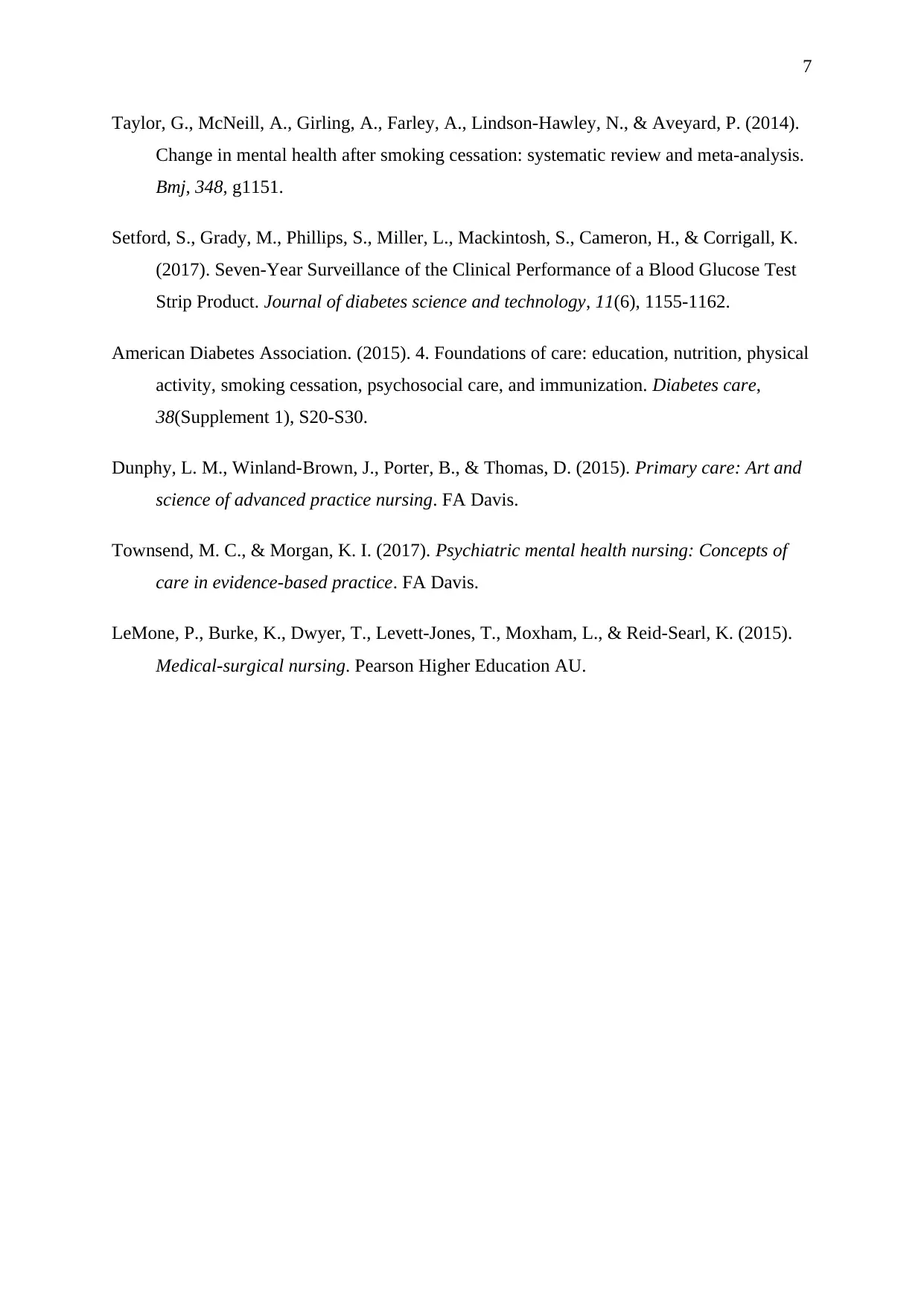
7
Taylor, G., McNeill, A., Girling, A., Farley, A., Lindson-Hawley, N., & Aveyard, P. (2014).
Change in mental health after smoking cessation: systematic review and meta-analysis.
Bmj, 348, g1151.
Setford, S., Grady, M., Phillips, S., Miller, L., Mackintosh, S., Cameron, H., & Corrigall, K.
(2017). Seven-Year Surveillance of the Clinical Performance of a Blood Glucose Test
Strip Product. Journal of diabetes science and technology, 11(6), 1155-1162.
American Diabetes Association. (2015). 4. Foundations of care: education, nutrition, physical
activity, smoking cessation, psychosocial care, and immunization. Diabetes care,
38(Supplement 1), S20-S30.
Dunphy, L. M., Winland-Brown, J., Porter, B., & Thomas, D. (2015). Primary care: Art and
science of advanced practice nursing. FA Davis.
Townsend, M. C., & Morgan, K. I. (2017). Psychiatric mental health nursing: Concepts of
care in evidence-based practice. FA Davis.
LeMone, P., Burke, K., Dwyer, T., Levett-Jones, T., Moxham, L., & Reid-Searl, K. (2015).
Medical-surgical nursing. Pearson Higher Education AU.
Taylor, G., McNeill, A., Girling, A., Farley, A., Lindson-Hawley, N., & Aveyard, P. (2014).
Change in mental health after smoking cessation: systematic review and meta-analysis.
Bmj, 348, g1151.
Setford, S., Grady, M., Phillips, S., Miller, L., Mackintosh, S., Cameron, H., & Corrigall, K.
(2017). Seven-Year Surveillance of the Clinical Performance of a Blood Glucose Test
Strip Product. Journal of diabetes science and technology, 11(6), 1155-1162.
American Diabetes Association. (2015). 4. Foundations of care: education, nutrition, physical
activity, smoking cessation, psychosocial care, and immunization. Diabetes care,
38(Supplement 1), S20-S30.
Dunphy, L. M., Winland-Brown, J., Porter, B., & Thomas, D. (2015). Primary care: Art and
science of advanced practice nursing. FA Davis.
Townsend, M. C., & Morgan, K. I. (2017). Psychiatric mental health nursing: Concepts of
care in evidence-based practice. FA Davis.
LeMone, P., Burke, K., Dwyer, T., Levett-Jones, T., Moxham, L., & Reid-Searl, K. (2015).
Medical-surgical nursing. Pearson Higher Education AU.
1 out of 7
Related Documents
Your All-in-One AI-Powered Toolkit for Academic Success.
+13062052269
info@desklib.com
Available 24*7 on WhatsApp / Email
![[object Object]](/_next/static/media/star-bottom.7253800d.svg)
Unlock your academic potential
Copyright © 2020–2025 A2Z Services. All Rights Reserved. Developed and managed by ZUCOL.





